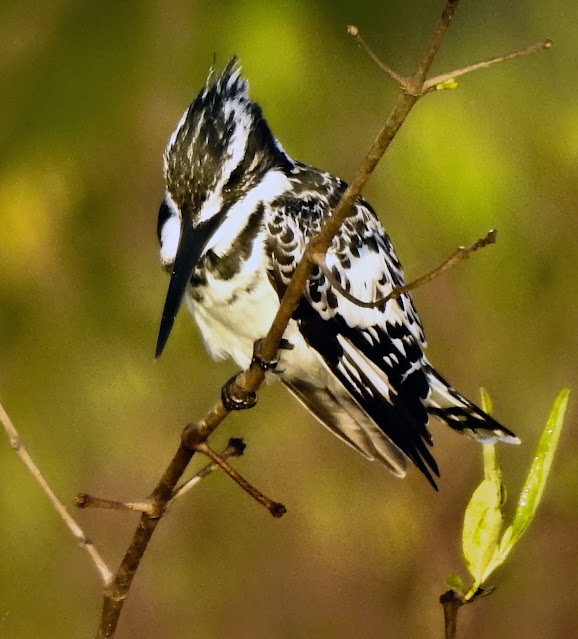This Blog contains Wildlife, Plants and Bird Photos from Walks, Safaris, Birding Trips and Vacations. Most of the pictures have been taken with my Nikon P900 and P950X cameras. Just click on any image for a larger picture. On the right column under the Blog Archive are the entries by date. Below that under Animal categories all the diffent species of Animals, Birds, Insects and Plants contained in the website are listed. Clicking on any entry will show all the entries for that species.
TOTAL PAGEVIEWS
TRANSLATE
Wednesday, 28 December 2022
27-12-2022 CAPE POINT, GAMBIA - BRUCE'S GREEN PIGEON (Treron waalia)
Bruce's green pigeon (Treron waalia), also known as the yellow-bellied fruit pigeon, is a species of bird in the family Columbidae. It is found in Benin, Burkina Faso, Cameroon, Central African Republic, Chad, Democratic Republic of the Congo, Ivory Coast, Djibouti, Eritrea, Ethiopia, Gambia, Ghana, Guinea, Guinea-Bissau, Kenya, Mali, Mauritania, Niger, Nigeria, Oman, Saudi Arabia, Senegal, Somalia, Sudan, Togo, Uganda, and Yemen. It is often found on farmland and near rivers. It is a frugivore bird species that specialises on eating the fruits of a single species of fig tree, Ficus platphylla. Unlike most birds, it does not have a uropygial gland.
Despite its name, Bruce's green pigeon is mostly grey with a light yellow breast and olive green upper wings .
18-12-2022 FARASUTO FOREST, GAMBIA - GEOMETER MOTH (Family Geometridae)
The geometer moths are moths belonging to the family Geometridae of the insect order Lepidoptera, the moths and butterflies. Their scientific name derives from the Ancient Greek geo γεω (derivative form of γῆ or γαῖα "the earth"), and metron μέτρον "measure" in reference to the way their larvae, or inchworms, appear to measure the earth as they move along in a looping fashion. A very large family, it has around 23,000 species of moths described, and over 1400 species from six subfamilies indigenous to North America alone. A well-known member is the peppered moth, Biston betularia, which has been subject of numerous studies in population genetics. Several other geometer moths are notorious pests.
18-12-2022 BAOBAB ISLAND, GAMBIA - AFRICAN SCOPS OWL (Otus senegalensis)
The African scops owl is strictly nocturnal. During the day, it perches close to the trunk of a tree.[8] When roosting in daylight, this species closes its eyes and extends its ear-tufts to give the impression of a tree branch, making it easily overlooked. Pairs sometimes roost together. The African scops owl is not as territorial as the Eurasian scops owl and will nest in loose aggregations, with the nest sites relatively close to each other.
The male and female may duet, calling all night both before and after leaving the roost site. The African scops owl lays four to six eggs directly onto the floor of a tree hollow, with laying occurring throughout April and June. Incubation lasts about 27 days, during which the female incubates the eggs and is fed by the male. Once the eggs hatch the young are fed by the female with food brought by the male. The young fledge in 30 days.
The prey of the African scops owl is mainly insects such as grasshoppers, beetles, crickets, moths etc. but also spiders, scorpions and small vertebrates. They normally hunt by scanning or listening from a perch and swooping down to capture prey on the ground, but will hawk for flying insects.
Tuesday, 27 December 2022
18-12-2022 FARASUTO FOREST, GAMBIA - GRAYISH EAGLE OWL (Bubo cinerascens)
The greyish eagle-owl or vermiculated eagle-owl (Bubo cinerascens) is a rather large owl of the northern part of sub-Saharan Africa. It was previously regarded as the northern subspecies of the spotted eagle-owl (Bubo africanus).
It is found in the northern part of sub-Saharan Africa from Mauritania and Liberia east to Sudan and Somalia. Its habitats include dry rocky deserts and open savannah, as well as lowland forests in Somalia.
18-12-2022 FARASUTO FOREST, GAMBIA - ABYSSINIAN ROLLER (Coracias abyssinicus)
Subscribe to:
Comments (Atom)
















































